INSTITUT SUPERIEUR D'ANTHROPOLOGIE
INSTITUT OF ANTHROPOLOGY
COURS ONLINE – COURS A DISTANCE
INSCRIPTIONS OUVERTES
REGISTER NOW
ITALIE - 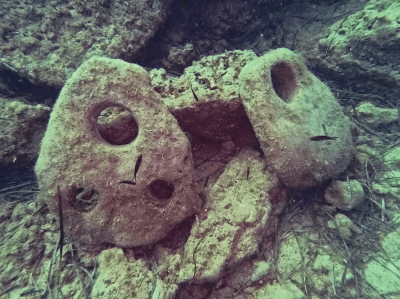 - Syracuse - During a joint operation by the Maritime Superintendency of the Sicilian Region and the Diving Unit of the Guardia di Finanza in Messina, two stone anchors from the Greek Archaic Period (800-480 BC) were discovered on the seabed off the coast of Syracuse, Sicily. The verification and survey operation was triggered by a report from a citizen who informed the relevant authorities of the presence of two stone anchors on the seabed of Siracusa. During the research, the two lithic anchors from the Archaic period (likely late Iron Age) were identified at a depth of 15 meters and documented with a three-dimensional photogrammetric study. The two archaeological finds were situated near to one another on a rocky seabed mixed with Posidonia meadows. The first was an ovoid-shaped anchor (gravity with a distal hole), and the other was a three-holed lithic anchor (gravity and socket) measuring about 70 centimeters in size. Divers from the Maritime Superintendency and the Diving Unit of the Guardia di Finanza in Messina inspected and documented a large marine area of approximately 250 square meters to confirm the presence of more archaeological evidence.
- Syracuse - During a joint operation by the Maritime Superintendency of the Sicilian Region and the Diving Unit of the Guardia di Finanza in Messina, two stone anchors from the Greek Archaic Period (800-480 BC) were discovered on the seabed off the coast of Syracuse, Sicily. The verification and survey operation was triggered by a report from a citizen who informed the relevant authorities of the presence of two stone anchors on the seabed of Siracusa. During the research, the two lithic anchors from the Archaic period (likely late Iron Age) were identified at a depth of 15 meters and documented with a three-dimensional photogrammetric study. The two archaeological finds were situated near to one another on a rocky seabed mixed with Posidonia meadows. The first was an ovoid-shaped anchor (gravity with a distal hole), and the other was a three-holed lithic anchor (gravity and socket) measuring about 70 centimeters in size. Divers from the Maritime Superintendency and the Diving Unit of the Guardia di Finanza in Messina inspected and documented a large marine area of approximately 250 square meters to confirm the presence of more archaeological evidence.
Important archaeological find in the seas of Sicily: Archaic stone anchors found off Syracuse - Arkeonews
JAPON - 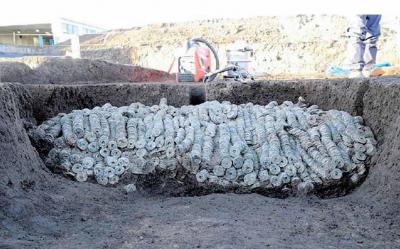 - Sojamachi - In the Kanto region of Central Japan, a trove of 100,000 ancient coins has been uncovered by city archaeologists, some of which date back 2,000 years. Stacked like cordwood in the Sojamachi district under a site where a company was planning to build a factory, many were minted in China, some as far back as the Western Han Dynasty (220 BCE – 9 CE). According to the Japanese daily Asahi Shimbun, 334 of the coins have so far been examined. 44 types have been identified, ranging from the time of Emperor Wendi (175 BCE) of the Western Han to ones as recent as the Kamakura Period (1185-1333). The paper didn’t say what the materials were, but given the mint and the burial method, they’re probably all copper or bronze. An innovation of the Chinese, the bronze and copper coins were minted with a hole in the middle. Along with saving material, it allowed for easy transport, storage, and counting as the coins could be slid down a rope made from straw or reeds and carried like a keychain. It was in this state that the coins were found, stacked and buried—perhaps hastily, according to Asahi Shimbun, whose report mentioned that they were found in property that belonged to wealthy members of the medieval Japanese society of Maebashi.
- Sojamachi - In the Kanto region of Central Japan, a trove of 100,000 ancient coins has been uncovered by city archaeologists, some of which date back 2,000 years. Stacked like cordwood in the Sojamachi district under a site where a company was planning to build a factory, many were minted in China, some as far back as the Western Han Dynasty (220 BCE – 9 CE). According to the Japanese daily Asahi Shimbun, 334 of the coins have so far been examined. 44 types have been identified, ranging from the time of Emperor Wendi (175 BCE) of the Western Han to ones as recent as the Kamakura Period (1185-1333). The paper didn’t say what the materials were, but given the mint and the burial method, they’re probably all copper or bronze. An innovation of the Chinese, the bronze and copper coins were minted with a hole in the middle. Along with saving material, it allowed for easy transport, storage, and counting as the coins could be slid down a rope made from straw or reeds and carried like a keychain. It was in this state that the coins were found, stacked and buried—perhaps hastily, according to Asahi Shimbun, whose report mentioned that they were found in property that belonged to wealthy members of the medieval Japanese society of Maebashi.
Scientists Discovered More Than 100,000 Ancient Coins at an Excavation Site in Japan (goodnewsnetwork.org)
ECOSSE – 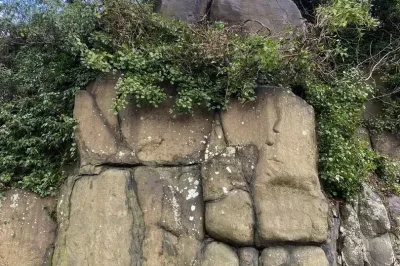 Stirling - The remains of a lost defensive tower in Stirling’s historic city walls have been uncovered by a team led by council archaeologist Dr Murray Cook. The location, in the old town cemetery, was used to guard an entrance next to what later became Cowane’s Hospital and dates back to around 1547. The tower was used to protect Stirling during a period known as the Rough Wooing, when English forces under the Duke of Somerset attempted to force a marriage between Mary, Queen of Scots and England’s Edward VI. It’s believed the towers were last in operation in 1746 against Bonnie Prince Charlie, during the Jacobite Uprising, before falling into a state of disrepair.
Stirling - The remains of a lost defensive tower in Stirling’s historic city walls have been uncovered by a team led by council archaeologist Dr Murray Cook. The location, in the old town cemetery, was used to guard an entrance next to what later became Cowane’s Hospital and dates back to around 1547. The tower was used to protect Stirling during a period known as the Rough Wooing, when English forces under the Duke of Somerset attempted to force a marriage between Mary, Queen of Scots and England’s Edward VI. It’s believed the towers were last in operation in 1746 against Bonnie Prince Charlie, during the Jacobite Uprising, before falling into a state of disrepair.
Lost Stirling city walls' tower found during excavations - Daily Record
ARABIE SAOUDITE – 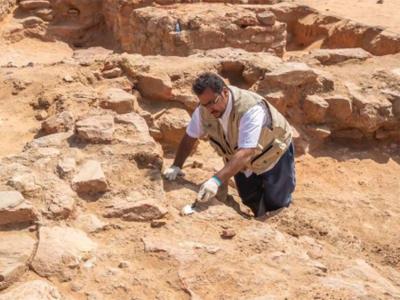 - Al Tweer - The Heritage Commission of the Saudi Ministry of Culture has uncovered artefacts at the Al Tweer archaeological site in Sakaka, a city in the Al Jawf region in northwest Saudi Arabia, dating back to between 300 BC and 100 AD. The Heritage Commission announced the completion of the first season of the archaeological excavation project at Al Tweer. The artefacts unearthed include architectural phenomena, water sources that were used for residential and agricultural activities, and the remnants of what is believed to be a watchtower or a religious facility. These structures and utilities date back to a period between 2300 and 1900 years ago, offering a glimpse into the life and culture of the inhabitants during that era. Among the most notable finds are an unfinished camel model made from pottery, various pottery vessels, and coins made of bronze and sandstone, all estimated to be around 2,300 years old. Earlier this month, the Royal Commission for AlUla (RCU) unveiled a 200,000-year-old axe dating back to the Paleolithic Age at the Qurh site in AlUla Governorate. The axe made from durable soft basalt stone measures 51.3cm in length and exhibits distinctive features suggesting its use for cutting or chopping purposes.
- Al Tweer - The Heritage Commission of the Saudi Ministry of Culture has uncovered artefacts at the Al Tweer archaeological site in Sakaka, a city in the Al Jawf region in northwest Saudi Arabia, dating back to between 300 BC and 100 AD. The Heritage Commission announced the completion of the first season of the archaeological excavation project at Al Tweer. The artefacts unearthed include architectural phenomena, water sources that were used for residential and agricultural activities, and the remnants of what is believed to be a watchtower or a religious facility. These structures and utilities date back to a period between 2300 and 1900 years ago, offering a glimpse into the life and culture of the inhabitants during that era. Among the most notable finds are an unfinished camel model made from pottery, various pottery vessels, and coins made of bronze and sandstone, all estimated to be around 2,300 years old. Earlier this month, the Royal Commission for AlUla (RCU) unveiled a 200,000-year-old axe dating back to the Paleolithic Age at the Qurh site in AlUla Governorate. The axe made from durable soft basalt stone measures 51.3cm in length and exhibits distinctive features suggesting its use for cutting or chopping purposes.
Saudi heritage commission discovers ancient artefacts in Al Tweer dating back to 300 BC | Saudi – Gulf News
ITALIE –  Capri - Italy divers recently found a chunk of obsidian in the remains of an ancient shipwreck near Capri. The ship likely dates back to the Neolithic period, also known as the New Stone Age. This piece of natural glass is as big as a huge book and weighs around 17.6 pounds (8 kilograms). There are marks on its surface where someone chiseled into it. Archaeologists believe it was an obsidian “core,” a tool used to create sharp-edged flakes for cutting things. On Monday (November 20th), divers from the Naples Police underwater unit brought up the artifact. They found it on the seafloor, about 100 to 130 feet (30 to 40 meters) below the surface, as stated by Italy’s Ministry of Culture. This obsidian core is the first item brought up from the wreckage, but experts believe there could be more. Archaeologists believe this natural glass was once part of the cargo on a ship during the Neolithic period over five thousand years ago.
Capri - Italy divers recently found a chunk of obsidian in the remains of an ancient shipwreck near Capri. The ship likely dates back to the Neolithic period, also known as the New Stone Age. This piece of natural glass is as big as a huge book and weighs around 17.6 pounds (8 kilograms). There are marks on its surface where someone chiseled into it. Archaeologists believe it was an obsidian “core,” a tool used to create sharp-edged flakes for cutting things. On Monday (November 20th), divers from the Naples Police underwater unit brought up the artifact. They found it on the seafloor, about 100 to 130 feet (30 to 40 meters) below the surface, as stated by Italy’s Ministry of Culture. This obsidian core is the first item brought up from the wreckage, but experts believe there could be more. Archaeologists believe this natural glass was once part of the cargo on a ship during the Neolithic period over five thousand years ago.
Divers Recover Obsidian Cores From Neolithic Shipwreck (greekreporter.com)
TURQUIE - 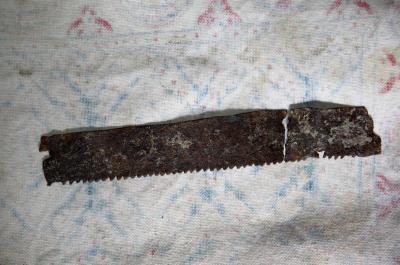 x Hattusha - rchaeologists discovered a 2,250-year-old saw during excavations at the ancient Hittite city of Hattusha in Türkiye’s central Çorum province. Professor Andreas Schachner, who leads the excavations, told Anadolu Agency (AA) that the iron of the saw was thicker than contemporary saws, but otherwise, it is very similar to the ones used today. “This shows us that humans do not simply modify working tools,” he said. The ancient tool is 20 centimeters long and was found in the northwestern side of the city. Professor Shachner noted that the discovery is a rare one and marks the first of its kind in Anatolia in the 3rd century B.C.
x Hattusha - rchaeologists discovered a 2,250-year-old saw during excavations at the ancient Hittite city of Hattusha in Türkiye’s central Çorum province. Professor Andreas Schachner, who leads the excavations, told Anadolu Agency (AA) that the iron of the saw was thicker than contemporary saws, but otherwise, it is very similar to the ones used today. “This shows us that humans do not simply modify working tools,” he said. The ancient tool is 20 centimeters long and was found in the northwestern side of the city. Professor Shachner noted that the discovery is a rare one and marks the first of its kind in Anatolia in the 3rd century B.C.
Rare 2,500-year-old saw discovered during excavations in Türkiye | Daily Sabah
POLOGNE – 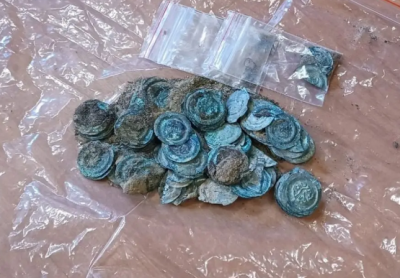 – Szprotawa - Archaeologists conducting excavations in the area of a former burgage plot in Szprotawa, Poland, have uncovered a treasure hoard of around 100 to 150 Silesian bracteate coins. A burgage was a town rental property “burgage tenement”, consisting of a house on a long and narrow plot of land with a narrow street frontage. Excavations unearthed the remains of a textile bag containing neatly arranged coins in cylinder piles. A closer examination has identified that the coins are mainly Silesian bracteates (Latin: “bractea” – plate) minted between 1250 to 1300. The coins are minted on one side from a thin plate on a soft base, which were introduced in Silesia after 1250 and phased out by thicker coins (the quarterly) during the early 14th century. They originate from the mint workshops of Silesia, although their use was relatively short as the coins were usually called back regularly (about once or twice a year) to be exchanged for new coins. In receiving three new coins for four old coins, the withheld 4th coin was called strike money and was often the only tax revenue of the coin mint-master. This system worked like a demurrage, with people often hoarding their coins because they lost their value. Excavations also discovered evidence of a bridge from the 15th to 16th century and the remains of the original city walls built during the 14th century.
– Szprotawa - Archaeologists conducting excavations in the area of a former burgage plot in Szprotawa, Poland, have uncovered a treasure hoard of around 100 to 150 Silesian bracteate coins. A burgage was a town rental property “burgage tenement”, consisting of a house on a long and narrow plot of land with a narrow street frontage. Excavations unearthed the remains of a textile bag containing neatly arranged coins in cylinder piles. A closer examination has identified that the coins are mainly Silesian bracteates (Latin: “bractea” – plate) minted between 1250 to 1300. The coins are minted on one side from a thin plate on a soft base, which were introduced in Silesia after 1250 and phased out by thicker coins (the quarterly) during the early 14th century. They originate from the mint workshops of Silesia, although their use was relatively short as the coins were usually called back regularly (about once or twice a year) to be exchanged for new coins. In receiving three new coins for four old coins, the withheld 4th coin was called strike money and was often the only tax revenue of the coin mint-master. This system worked like a demurrage, with people often hoarding their coins because they lost their value. Excavations also discovered evidence of a bridge from the 15th to 16th century and the remains of the original city walls built during the 14th century.
Treasure hoard of Silesian bracteates found in Szprotawa (heritagedaily.com)
ITALIE - 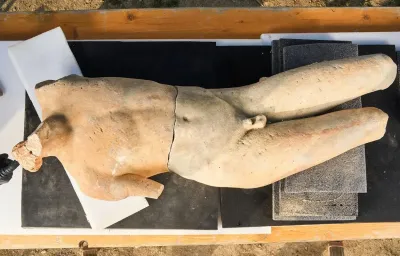 San Casciano dei Bagni- - Archaeologists have found a marble statue of Apollo Sauroctonos, also known as the “Lizard Killer”, during excavations of an Etruscan and Roman spa at San Casciano dei Bagni in Tuscany. The spa is fed by geothermal springs, which the Etruscans used to supply water at a mean temperature of 42 °C (108 °F) to the complex of Balnea Clusinae. During the Roman period, the spa became a popular attraction for the therapeutic benefits, with notable figures such as Caesar Augustus being a frequent visitor. Archaeologists have found fragments of a life-sized Apollo Sauroctonos statue on the edge of the Great Bath, which are Roman copies of a bronze statue created by the Greek sculptor Praxiteles, the most renowned of the Attica sculptors of the 4th century BC. Example copies generally date from the 1st to 2nd century AD and depict Apollo in his youth about to catch a lizard climbing up a tree. The Roman poet, Martial, wrote an epigram about the Apollo Sauroctonos statues “Spare the lizard, treacherous boy, creeping toward you; it desires to perish by your hands.” Apollo, revered as the deity associated with healing and ailments, received votive offerings from petitioners seeking remedies for their afflictions. Additionally, the depiction of Apollo hunting a lizard can be associated with ophthalmology, as lizards were considered a key ingredient for curing eye complaints.Excavations also uncovered a travertine votive altar with a bilingual inscription in Latin and Etruscan from the 1st century AD, indicating the ongoing influence of Etruscan culture well into the Roman Imperial Era.
San Casciano dei Bagni- - Archaeologists have found a marble statue of Apollo Sauroctonos, also known as the “Lizard Killer”, during excavations of an Etruscan and Roman spa at San Casciano dei Bagni in Tuscany. The spa is fed by geothermal springs, which the Etruscans used to supply water at a mean temperature of 42 °C (108 °F) to the complex of Balnea Clusinae. During the Roman period, the spa became a popular attraction for the therapeutic benefits, with notable figures such as Caesar Augustus being a frequent visitor. Archaeologists have found fragments of a life-sized Apollo Sauroctonos statue on the edge of the Great Bath, which are Roman copies of a bronze statue created by the Greek sculptor Praxiteles, the most renowned of the Attica sculptors of the 4th century BC. Example copies generally date from the 1st to 2nd century AD and depict Apollo in his youth about to catch a lizard climbing up a tree. The Roman poet, Martial, wrote an epigram about the Apollo Sauroctonos statues “Spare the lizard, treacherous boy, creeping toward you; it desires to perish by your hands.” Apollo, revered as the deity associated with healing and ailments, received votive offerings from petitioners seeking remedies for their afflictions. Additionally, the depiction of Apollo hunting a lizard can be associated with ophthalmology, as lizards were considered a key ingredient for curing eye complaints.Excavations also uncovered a travertine votive altar with a bilingual inscription in Latin and Etruscan from the 1st century AD, indicating the ongoing influence of Etruscan culture well into the Roman Imperial Era.
Statue of Apollo “Lizard Killer” found at Etruscan and Roman spa (heritagedaily.com)
MEXIQUE – 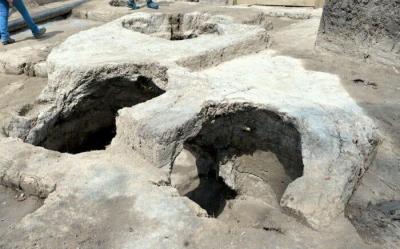
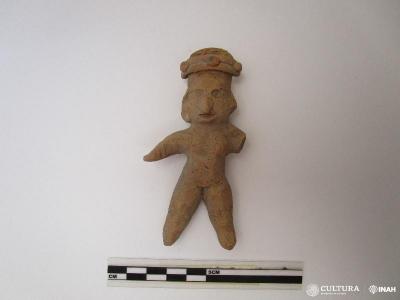 Lomas de Chapultepec - Archaeologists from the National Institute of Anthropology and History (INAH) unearthed 10 truncated conical tombs, approximately 3,000 years old, at the edge of the third section of the Chapultepec Forest. The discovery, according to the archaeological excavations’ coordinator, María de Lourdes López Camacho, refers to a large village that must have existed in this area of the Lomas de Chapultepec, at the edge of the forest, during the Early and Middle Preclassic periods (2500-400 BC). During the Classic Period, the Teotihuacan culture inhabited the region, with later evidence of the Tepanecas of Azcapotzalco and the Mexica (Aztecs). This tombs is located on a promontory, at the height of Cri-Cri Park, where a Cablebús station was built, and it is more than the first time that The funerary architecture of the first agricultural villages is located in the territory currently occupied west of Mexico City, and at such a high altitude: 2,416 meters above sea level. The diameters of the graves vary between one and two meters and the maximum height is 1.50 meters. In total, a dozen truncated conical tombs have been recorded, defined by their inverted cone shape truncated at a point, so they are also known as bottle or bell tombs. Five of the tombs contained deposits of human remains, four of which are female and one is male, all of which are positioned in a flexed form. “This is a particular funerary architecture. Examples of these tombs can be found elsewhere in ancient Mexico., such as the Gulf coast and the west, is also located in the current states of Mexico and Morelos, and there are records in the south, north and east of the Basin of Mexico. We had to look for them in the western part, now they are there,” explained archaeologist López Camacho. Preliminarily, the truncated conical tombs are from the Middle Preclassic period (1200-400 BC), but they are close to the Early Preclassic period (2500-1200 BC) based on the characteristics of the associated materials. At a higher level, the archaeological rescue team discovered three burials in rectangular cists arranged in an east-west axis. This suggests that the aforementioned village lasted long after the Preclassic period. Excavations also discovered funerary offerings consisting of deer antlers worked as tools, a concave-convex cup, a fragment of a slate disc, punches, a concave cup, female figurines, effigy vessels, and figurines in schematic parts that archaeologists call “ghosts”.
Lomas de Chapultepec - Archaeologists from the National Institute of Anthropology and History (INAH) unearthed 10 truncated conical tombs, approximately 3,000 years old, at the edge of the third section of the Chapultepec Forest. The discovery, according to the archaeological excavations’ coordinator, María de Lourdes López Camacho, refers to a large village that must have existed in this area of the Lomas de Chapultepec, at the edge of the forest, during the Early and Middle Preclassic periods (2500-400 BC). During the Classic Period, the Teotihuacan culture inhabited the region, with later evidence of the Tepanecas of Azcapotzalco and the Mexica (Aztecs). This tombs is located on a promontory, at the height of Cri-Cri Park, where a Cablebús station was built, and it is more than the first time that The funerary architecture of the first agricultural villages is located in the territory currently occupied west of Mexico City, and at such a high altitude: 2,416 meters above sea level. The diameters of the graves vary between one and two meters and the maximum height is 1.50 meters. In total, a dozen truncated conical tombs have been recorded, defined by their inverted cone shape truncated at a point, so they are also known as bottle or bell tombs. Five of the tombs contained deposits of human remains, four of which are female and one is male, all of which are positioned in a flexed form. “This is a particular funerary architecture. Examples of these tombs can be found elsewhere in ancient Mexico., such as the Gulf coast and the west, is also located in the current states of Mexico and Morelos, and there are records in the south, north and east of the Basin of Mexico. We had to look for them in the western part, now they are there,” explained archaeologist López Camacho. Preliminarily, the truncated conical tombs are from the Middle Preclassic period (1200-400 BC), but they are close to the Early Preclassic period (2500-1200 BC) based on the characteristics of the associated materials. At a higher level, the archaeological rescue team discovered three burials in rectangular cists arranged in an east-west axis. This suggests that the aforementioned village lasted long after the Preclassic period. Excavations also discovered funerary offerings consisting of deer antlers worked as tools, a concave-convex cup, a fragment of a slate disc, punches, a concave cup, female figurines, effigy vessels, and figurines in schematic parts that archaeologists call “ghosts”.
Truncated conical tombs 3,000 years old found in the Chapultepec Forest - Arkeonews AA
ALLEMAGNE – 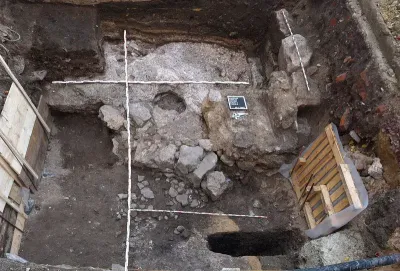 Magdeburg - Archaeologists working at Magdeburg’s Cathedral Square in eastern Germany have uncovered the remains of a large medieval building thought to be over a thousand years old. For the first time, actual architectural remains were found in the form of two walls – the outer wall of a semicircular room (apse) and a wall base at its north end that runs west – which can be assigned to a building from the Ottonian period (919–1024). On the former outside of the building, both walls to the west have a sloping base made of plaster mortar, which was primarily used to protect against moisture. The outer wall of the apse appears to have been structured by half-columns or pilasters. It was part of the western end of the building, which extended to the east parallel to a cathedral that was built around the same time. “These are the remains of two walls from the time of Otto the Great (912-973) or his successors,” excavation manager Holger Grönwald said to Aussidlerbotte Zeitung. “The remains come from the outer wall of a semi-circular room, a so-called apse, as well as a wall base.” Magdeburg was an important city for Emperor Otto I (912 to 973), known as the Great, in the 10th century. Here, the founder of the Holy Roman Empire endowed the Moritz Monastery and the first Magdeburg Cathedral, magnificently furnished the new buildings with imported antique marble columns and established a basis for Magdeburg’s rise to one of the most important cities of the Middle Ages. This discovery should help answer questions about the location and architecture of these buildings and allow historians to piece together what 10th-century Magdeburg looked like. Despite its massive and high-quality construction, this Ottonian building did not last long. Its remains are clearly overlaid by walls and the remains of a door frame, which was part of a bishop’s palace, built by Norbert von Xanten, Archbishop of Magdeburg (1126-1134). This later building was in turn destroyed by a fire that swept through the city in 1207. The new findings provide a glimpse of the Ottonian building assemblage, which was believed to have been largely lost. The excavations highlight the considerable potential for archaeological research at this historically highly important site.
Magdeburg - Archaeologists working at Magdeburg’s Cathedral Square in eastern Germany have uncovered the remains of a large medieval building thought to be over a thousand years old. For the first time, actual architectural remains were found in the form of two walls – the outer wall of a semicircular room (apse) and a wall base at its north end that runs west – which can be assigned to a building from the Ottonian period (919–1024). On the former outside of the building, both walls to the west have a sloping base made of plaster mortar, which was primarily used to protect against moisture. The outer wall of the apse appears to have been structured by half-columns or pilasters. It was part of the western end of the building, which extended to the east parallel to a cathedral that was built around the same time. “These are the remains of two walls from the time of Otto the Great (912-973) or his successors,” excavation manager Holger Grönwald said to Aussidlerbotte Zeitung. “The remains come from the outer wall of a semi-circular room, a so-called apse, as well as a wall base.” Magdeburg was an important city for Emperor Otto I (912 to 973), known as the Great, in the 10th century. Here, the founder of the Holy Roman Empire endowed the Moritz Monastery and the first Magdeburg Cathedral, magnificently furnished the new buildings with imported antique marble columns and established a basis for Magdeburg’s rise to one of the most important cities of the Middle Ages. This discovery should help answer questions about the location and architecture of these buildings and allow historians to piece together what 10th-century Magdeburg looked like. Despite its massive and high-quality construction, this Ottonian building did not last long. Its remains are clearly overlaid by walls and the remains of a door frame, which was part of a bishop’s palace, built by Norbert von Xanten, Archbishop of Magdeburg (1126-1134). This later building was in turn destroyed by a fire that swept through the city in 1207. The new findings provide a glimpse of the Ottonian building assemblage, which was believed to have been largely lost. The excavations highlight the considerable potential for archaeological research at this historically highly important site.
Medieval building discovered by archaeologists in Germany - Medievalists.net
ESTONIE – 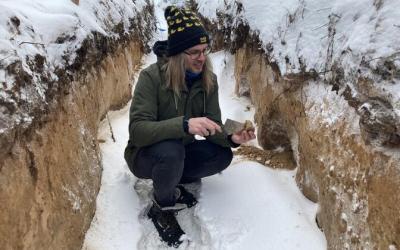 Kuremäe - Work to install a geothermal heating system for the Kuremäe Library revealed an ancient burial site. Construction work that ignored prior agreements caused significant damage to remains. "When the officials arrived in Kuremäe a part of the work had already been done. This despite a prior agreement according to which a heritage conservation archeologist would come and help with the dig. The ditch had already been dug when they arrived. A part of the skeletons had been unearthed, while some were still visible in the soil," said Anu Lillak, archeology adviser for the National Heritage Board. The burial site is quite likely Votian based on the origin of nearby burial mounds. The most famous Votian burial mound in Estonia is located in nearby Jõuga. The last time burial sites were discovered in the area was in 2003 when construction work to build a parking lot near the Kuremäe sacred spring unearthed 11 burials from the 12-15th centuries "The dig has cut through at least five burials at first glance. But a walk around the site revealed that number could be higher. We found several skull fragments despite the profile of the dig suggesting the skulls should still be in the ground, meaning that more burials may have been affected," said Martin Malve who studies bones. The entire area was designated a temporary protected zone after the incident.
Kuremäe - Work to install a geothermal heating system for the Kuremäe Library revealed an ancient burial site. Construction work that ignored prior agreements caused significant damage to remains. "When the officials arrived in Kuremäe a part of the work had already been done. This despite a prior agreement according to which a heritage conservation archeologist would come and help with the dig. The ditch had already been dug when they arrived. A part of the skeletons had been unearthed, while some were still visible in the soil," said Anu Lillak, archeology adviser for the National Heritage Board. The burial site is quite likely Votian based on the origin of nearby burial mounds. The most famous Votian burial mound in Estonia is located in nearby Jõuga. The last time burial sites were discovered in the area was in 2003 when construction work to build a parking lot near the Kuremäe sacred spring unearthed 11 burials from the 12-15th centuries "The dig has cut through at least five burials at first glance. But a walk around the site revealed that number could be higher. We found several skull fragments despite the profile of the dig suggesting the skulls should still be in the ground, meaning that more burials may have been affected," said Martin Malve who studies bones. The entire area was designated a temporary protected zone after the incident.
Suspected Votian burial site damaged during excavation work | News | ERR